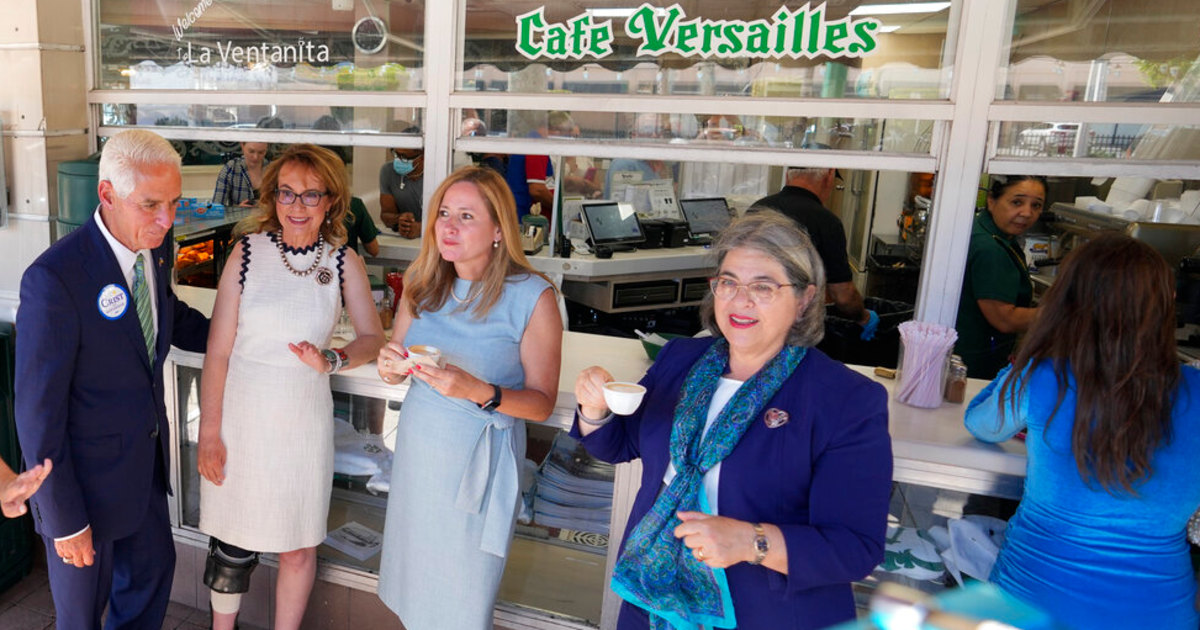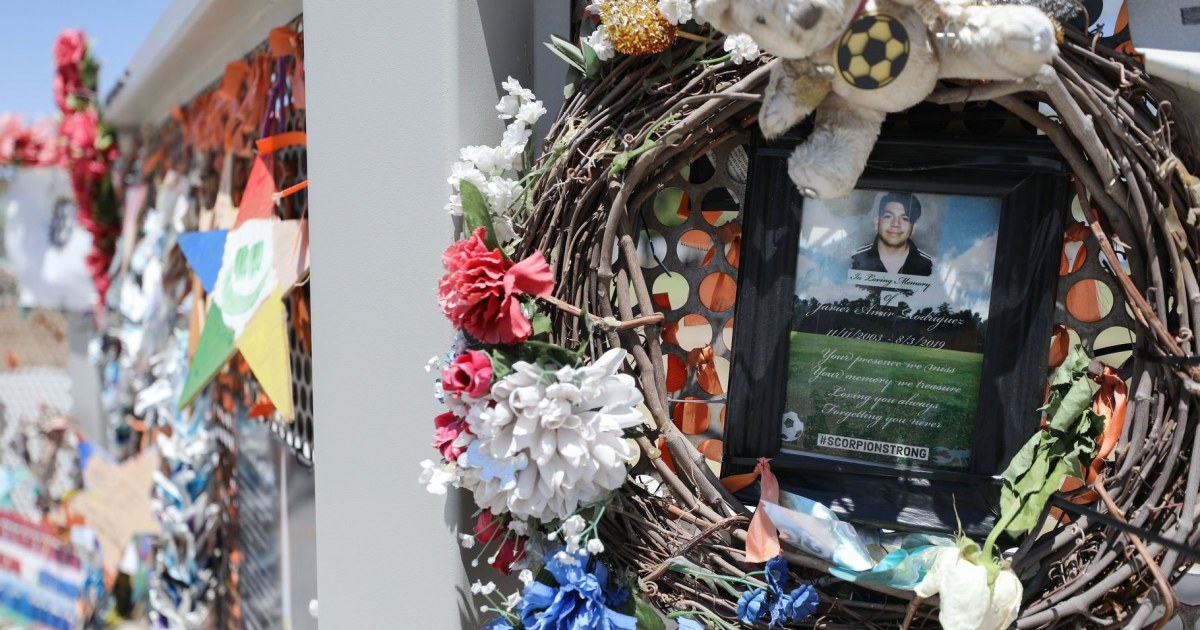Welcome to Axios Latino, a newsletter to tell you every Tuesday and Thursday the stories that have a special impact on Latino communities in the United States and in Latin America. If you are interested in subscribing and receiving the newsletter in your email (
in English
), you can do so
by clicking here
.
You will always find it in Spanish on Noticias Telemundo.
1 topic to highlight: Technology to make life easier for Latinos with disabilities
Latinos with disabilities tend to have a poorer quality of life than other demographic groups in the United States, an imbalance that is sought to alleviate with the development of new technologies.
Why it matters
: One in six Latino adults in the country has a disability.
As the Hispanic population grows, more people are likely to need support for this reason.
The Big Picture:
More than 5.4 million Hispanics, 9% of the Latino population of any age in the United States, have a disability.
It is a lower rate than for non-Hispanic blacks, Native Americans, and whites.
But Hispanics report higher levels of disability unemployment, have higher dropout rates, and get fewer advanced assistive devices (such as motorized wheelchairs).
Latinos with disabilities also have twice the risk than non-Hispanic whites of suffering a deterioration in health and being more limited in the activities they can carry out.
Barriers caused by language, cultural stigmas according to which seeking help is a sign of weakness, lower rates of health insurance and fears about immigration status can affect their development as people with disabilities ranging from mental and physical health to cognitive disorders .
Shoshanna Gordon / Axios
Technologies and services have emerged
to support those Latinos:
An app being developed by a Mexican teenager helps those who use sign language to communicate more easily by translating it into text or voice, and vice versa.
A video relay service available in Spanish and English that provides on-the-spot interpretation from sign language, from the company Purple Communication, has just joined forces with Meta to offer its services on Facebook devices and to facilitate access to interpretation. in video calls.
The non-profit association World Institute on Disability has several digital tools, including the bilingual initiative Proyecto Visión, with job training services for people with disabilities, advice on managing budgets and on how to maintain disability benefits.
[Reggaeton in sign language: this young Hispanic makes popular songs of the moment more accessible]
By the numbers
: 26% of Hispanics with disabilities in the United States live in poverty, compared to 17% of non-Hispanic whites and 32% of blacks with disabilities, according to the University of New Hampshire analysis.
Latinos with disabilities are less likely to have health insurance: 11%, on the national average, do not have it, in contrast to 6% of blacks, non-Hispanic whites, Asians, and Native Americans with disabilities.
In his own words
: "Technology has undoubtedly improved the mechanisms to communicate, to feel more connected, such as applications that translate what people say so that we have access to everyday activities such as being able to take a guided tour in museums or order a coffee ", says Elvia Guillermo Aguilar, Mexican-American in charge of intercultural alliances in the Office of Equity, Inclusion and Diversity of the Gallaudet University, dedicated to people with deafness or hard of hearing.
Although Guillermo Aguilar also points out in an interview via an interpreter that technologies - even in times of pandemic - have their drawbacks because they make it difficult to generate a feeling of belonging for cultures such as people with deafness, which depend a lot on direct interaction to read lips or see the entire torso of someone for any sign that requires more gesturing.
The Mexican also indicated that technology still does not eliminate other problems that Latinos usually face, regardless of whether they have a disability: "Sometimes it is still difficult for certain people to understand me, because I speak with an accent, in a way, since My first language is Mexican Sign Language and my style, even when I use American Sign Language, comes from that experience. "
They prepare a soccer tournament with players who have visual disabilities in Mexico City
Dec. 6, 202101: 07
Overview:
13% of the population in Latin America and the Caribbean, a region with even greater accessibility challenges, has a disability.
But non-governmental organizations and some local authorities have been working to reduce these inequalities.
In La Paz, Bolivia, for example, cable car systems have integrated mobility tools so that more people can use it.
In the Brazilian state of São Paulo, in the town of Campinas, in recent years they have inaugurated playgrounds designed with children using wheelchairs in mind.
In the educational field, organizations such as the Colombian Asodisvalle have also filled the gaps in public policies with an educational center for children with various types of disabilities in Cali.
Asodisvalle's manager, cerebral palsy activist Jeison Aristizábal, has also raised funds from other NGOs and celebrities like Maluma to build a university that will give special vocational workshops and have a rehabilitation center.
2. Alert for increased exposure to opioids for Latinos
The likelihood of doctors prescribing opioid-derived pain relievers has increased for Hispanic and black adults in the United States over the past two decades, new research warns.
Why It Matters
: Efforts to tackle the opioid crisis are currently focused primarily on the non-Hispanic white population.
Research suggests that this is leaving behind other populations that may be affected by opioid misuse, and that those demographics are also not getting the resources they need to deal with their pain.
A bottle of opiate-derived pain relievers John Tlumacki / The Boston Globe via Getty Images
Context
: In the 1990s, black and Latino people were less prescribed opioid pain relievers than non-Hispanic whites, but that changed over time even as other non-derivative pain relievers and treatments became more widely available. of opiates.
Recent research, published in the American Journal of Preventive Medicine, proposes that this trend indicates that there is insufficient treatment for non-whites by implying that they are given less access to mechanisms to manage pain.
Other studies have already pointed out that Hispanics in the United States receive fewer prescriptions for pain medications even when their pain levels are comparable to those of other populations.
In 2020, the Substance Abuse and Mental Health Services Administration (SAMHSA) had already warned of a “dramatic increase” in overdose deaths and opioid abuse among non-white communities, especially Latinas.
[The pandemic triggers opioid overdoses and Latinos are the most vulnerable]
3. There are more Latino students, but no more Hispanics advocating for them.
Almost 90% of school board members in the United States say they have never lived in those institutions with Latino colleagues, according to a recent survey by the EdWeek Research Center group.
Another survey, conducted in 2018 by the National School Boards Association, found that only 3 percent of board members are Hispanic, compared to 78% on average for non-Hispanic whites and 10% for non-Hispanic blacks.
Why it matters:
The fact that there are so few latios on school boards, which are intended to give a voice to the neighbors and parents of public schools, underscores the lack of avenues for political empowerment.
And it happens even as the Latino student population has exploded.
Hispanics are thus excluded from decision-making that is relevant to those students.
For example, in several states there are school boards and student parent associations that advocate for the removal of books they consider controversial for addressing diversity issues - including several by Latino authors - from student reading lists and library shelves. school libraries.
Latino parents at a school meeting at a Minneapolis elementary school Marlin Levison / Star Tribune via Getty Images
More details
: The number of Latino students in public schools grew from 22% to 27% between the fall semester of 2009 and the fall semester of 2018, according to data from the federal government.
In several states the percentages are much higher: in New Mexico they represent 62% of the student body;
in California, 55%;
in Texas they add up to 52%;
in Arizona they are 47%;
and in Nevada they reach 44%, according to the Pew Research Center.
4. The fights with the Latinos for the new electoral districts
Skyrocketing population growth among Latinos living in urban areas in the US is creating tensions over decisions about what new constituencies will look like.
The background
: Districts are being redrawn as a result of the 2020 Census and ahead of legislative votes in November this year.
But in several cities, those new districts with more Latino populations would be cutting back and reducing historically black areas.
More details
: Black and Latino activists in Chicago have had friction over how they believe the city's 50 legislative districts should be redrawn.
Chicago's Latino population increased 5% in the last decade, but the Latino population decreased 10%.
Shoshanna Gordon / Axios
In Milwaukee, Mayor Tom Barrett vetoed a new electoral map made by the local council in December after Latino activists called for a third Hispanic-majority district to be established.
In November, the Clark County Commission (where Las Vegas, Nevada is located) voted in favor of a new district map after various demographic groups had to make concessions.
It remained a black-majority district, but there was criticism that it was at the cost of dividing up areas with more Latino and Asian-descent inhabitants.
Context
: The Latino population in the United States increased 23% in the last decade, but several metropolitan areas had up to three times greater Latino growth.
At the same time, in almost half of the 50 largest cities in the country, the percentage of the black population, who moved to the suburbs, declined, according to a Census analysis by the Brookings Institution.
Latinos and people of Asian descent are moving into those historically black city districts created after civil rights protests and through unrepresentative lawsuits.
5. Summary of key news in Latin America and the Caribbean
The Venezuelan opposition once again defeated
the ruling party in the state of Barinas, historically a stronghold of the PSUV since the late former president Hugo Chávez was born there.
Sergio Garrido was declared the winner of the gubernatorial election on Sunday.
The original election had been in November, when the previous opposition candidate, Freddy Superlano, prevailed over incumbent Argenis Chávez - brother of the late president.
However, that vote was annulled and Superlano was retroactively disqualified due to an administrative sanction.
Even so, Argenis Chávez acknowledged that he was losing and withdrew from the race.
In his place, former Foreign Minister Jorge Arreaza ran for Chavez.
Sunday's election was the first time in two decades that no one with the last name Chávez appeared on the Barinas ballot.
Daniel Ortega assumes his fifth term in Nicaragua amid US and European Union sanctions
Jan. 11, 202200: 21
Nicaragua received a wave of new sanctions on Monday
from the United States and the European Union.
They coincided with the inauguration of Daniel Ortega and Rosario Murillo (vice president and first lady) for a fourth consecutive presidential term.
Ortega and Murillo took office despite multiple allegations of electoral fraud as their regime arrested virtually all rival candidates and other opponents.
The new joint sanctions were imposed against officials such as the Nicaraguan Defense Minister and two of the sons of Ortega and Murillo.
The presidential couple was already sanctioned.
6. A look at the secret ceremonies of post-conquest Aztecs
Beneath the territory of the mariachis in Mexico City is a 16th century Aztec-era altar recently discovered by archaeologists.
Details
: The altar with ashes in an urn and incense burners (incense burners) was found underground just off Plaza Garibaldi, where mariachis gather every night to delight bar diners.
The archaeologists behind the find say that the site, an old adobe house, is especially notable because the altar found there was placed after the conquest.
It thus demonstrates how Aztec traditions, such as erecting altars when someone died, continued, albeit secretly, when Spanish settlers were already promoting religious conversion.
Overview
: Similar to Pompeii, where most of the city is still underground (in this case, from a volcanic eruption) while archaeologists dig in bit by bit, new finds from Mesoamerican cultures continue to be uncovered.
In and around Mexico City, once the Aztec capital Tenochtitlan, those finds are especially common when excavating because the Spanish largely built directly on top of it.
They unearth an Aztec altar found in the Garibaldi square in Mexico City
Dec. 6, 202101: 37
Thanks for reading, we'll be back on Thursday.
Do you want to see any of the most recent previous editions?
Hispanics make their way into the tattoo world
The Latinx
debate
grows
This is how Hispanics made the first Christmases in America
The Mexican behind Snoopy
The effects of the wage gap
Remember school segregation









